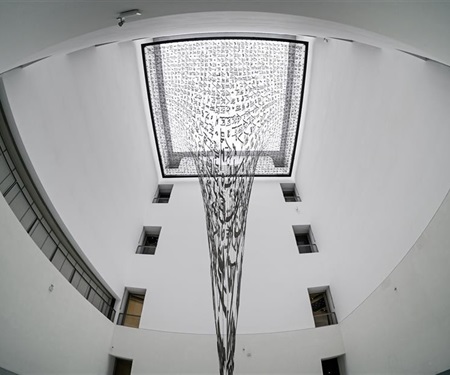Exhibition — Xu Bing: Gravitational Arena
Capturing the tension, interaction and relationship among different civilizations.
by SHINE
Commissioned work can often be a double-edged sword for an artist. An exceptional piece can boost the artist's reputation within the art community, while a mediocre work can become a lingering "scar" on their reputation.
Xu Bing's "Gravitational Arena," recently installed in the Exhibition Hall X of the Museum of Art Pudong (MAP), is certainly an example of the former. Interestingly, the same space previously showcased a commissioned work by world-renowned Chinese firecracker artist, Cai Guoqiang.
Moreover, Xu's installation surpasses expectations, in both form and content.
Upon entering the exhibition space, visitors are likely to be astounded by the scale of this mammoth creation. A towering vortex of characters, stretching down from over 30 meters above, dominates the hall. Amidst the tension and distortion caused by gravity, these characters are reflected by a large mirror on the floor, generating an impression of depth that interplays with the artwork and the space itself.
Produced by the Lujiazui Group and organized by MAP, the work consists of 1,600 metal "Square Word Calligraphy" characters. The installation, which is situated in a space offering views through windows across multiple floors, took nearly a month to complete.
This new piece is also part of Xu's ongoing solo exhibition at MAP, which continues until November 13.
For those unfamiliar with Xu and his earlier works, it would be beneficial to conduct some online research before visiting, or to carefully read the exhibition pamphlet and wall texts within the space. "Square Word Calligraphy" is one of Xu's most celebrated series.
In Square Word Calligraphy, Xu designed a calligraphic system whereby English words take on the appearance of Chinese characters. As a linguistic innovator, he merges Chinese calligraphy with English writing to create a unique blend that carries real meanings.
"Square Word Calligraphy" is an excerpt from Ludwig Wittgenstein's "Philosophical Investigations." From a linguistic philosophy standpoint, Wittgenstein highlights misunderstandings in human cognition arising from language use. Inspired by this, Xu suggests "that like all languages, 'perspective' serves as an intermediary between our mental thoughts and the external world. Various languages unwittingly shape our thinking, just as any language does, so our thinking inevitably has blind spots."
Born in Chongqing in 1955, Xu is among the first contemporary Chinese artists to achieve international recognition, a status he maintains to this day. He is widely celebrated as a leading conceptual artist, engaging deeply with language and semiotics, the study of signs, symbols, and their interpretations. Xu's works have been exhibited in renowned art museums worldwide, including the National Art Museum of China, New York's Museum of Modern Art and Metropolitan Museum of Art, as well as London's British Museum and Victoria and Albert Museum.
The title of the piece, Gravitational Arena, embodies a myriad of profound meanings for the artist.
"The form and mirror reflection of the artwork resemble the 'wormhole model', while the term 'arena' hints at the theatrical experience when viewed from varying perspectives on different floors," Xu explained. "By modeling the entanglement of matter in the universe, I aim for this piece to provoke contemplation on the tensions, interactions, and wrestling-like relationships among different civilizations.”

